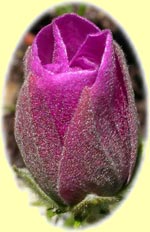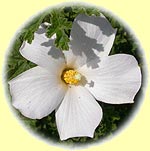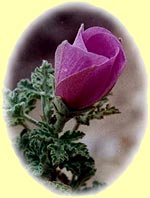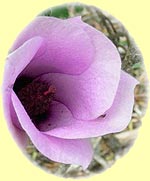 |
| Search this site: |
Alyogynes in the Sub-tropics. Selected species and Crosses Continued
A further cross was made from these Alyogynes. Alyogyne “Christopher Noble”, with vibrant colour, bright pink stigma pads and the longest stem of any seedling, was crossed back to Alyogyne “West Coast Gem”. SEE FIGURE 5
 |
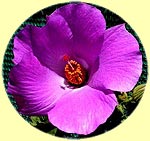 |
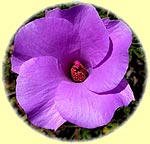 |
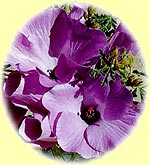 |
| Alyogyne 'Christopher Noble' | Alyogyne 'Lisle' | ||
| FIGURE 5: Pod parent Alyogyne 'West Coast Gem' (see Figure 1) Pollen parent Alogyne 'Christopher Noble'; Seedling Alogyne 'Lisle' |
|||
I consider that the resulting seedling Alyogyne “‘Lisle” remains the best seedling that I have. It blooms even earlier than Alyogyne “West Coast Gem” and has its overlapping petals and ‘felty’ buds. It has the bright pink stigma pads and long stem of Alyogyne “Christopher Noble”. In our conditions, it also has a longer flowering period than any of the Alyogynes previously mentioned, usually blooming from early winter until early summer and it lives longer than any of the Alyogynes in its parentage. The flowers last well when picked and the longer stems, up to 6 cm, are an asset when arranging A. “Lisle” in a vase. A seedling of A. “Lisle” x A. “Lisle” called "Misty" displays the overlapping petals and the bright pink stigma pads of its parent.
Two more crosses were made.
The first of these was made when a white form of Alyogyne huegelii was grown. In our conditions, Alyogyne huegelii alba is a lower growing Alyogyne which has infrequent blooms. This is in contrast to plants grown by a friend in Victoria where the plant blooms over an extended period. The pink tulip-shaped bloom was the pod parent and the white bloom was the pollen parent. The seedling was called A. “Gilly”. SEE FIGURE 6
The blooms are quite small but cover the plant. The flowers are initially pink but fade almost to mauve. The foliage feels like felt and gives the bush an attractive appearance. This Alyogyne flowers even longer into summer than its pod parent, with blooms appearing until mid-summer. Given the small size of the blooms, I think that this cross would be more suitable for a collector.
The last cross occurred when we were able to obtain the mauve-flowering form of the tulip-shaped Alyogyne in a nursery in Toowoomba. The first of the following photos was taken by Gil Bujanda in his garden in California. The second and third photos are of a seedling grown from seed taken from the species. This seedling was named A. “Pete’s Mauve”. The bloom is a slightly deeper colour than the species, is slightly larger and has better texture. Flowering is as prolific as on the pod parent. This plant is taller than any of the Alyogynes already mentioned, so is valuable in landscaping. SEE FIGURE 7
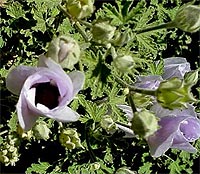 |
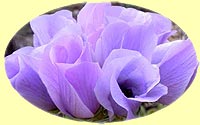 |
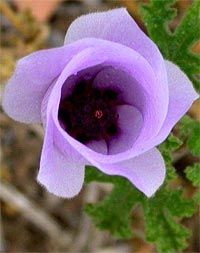 |
| Pod parent: mauve tulip; pollen parent unknown | Seedling, Alyogyne 'Pete's Mauve' | |
| FIGURE 7: Pod parent Alyogyne huegelii mauve tulip Pollen parent Unknown; Seedling Alyogyne 'Pete's Mauve' | ||
All these seedlings have the profuse flowering of their pod parents. Even where the pollen parent has few flowers, the resulting seedling, A. “Gilly”, flowers prolifically.
SUMMARY OF EXPERIENCES WITH ALYOGYNE HUEGELII.Although it may now be possible to obtain other species, if I were starting again to develop plants that are more hardy for the sub-tropics, I think I would still start with the same three Alyogynes. They have many features of value, such as profuse flowering, even in a sub-tropical climate. With a planned program of crosses, it has been possible to maintain this flowering yet develop a wider range of colours on plants that flower over longer periods. Of even greater importance, the more recent crosses such as A. ‘Lisle’ live longer than the original plants.
If my main interest were landscaping, I would add in Alyogyne huegelii alba, because of its lower growth habit, even although it does not produce many flowers. I would also grow Alyogyne “Pete’s Mauve”, because of its prolific flowering and because it adds height to a planting of Alyogynes.
FUTURE DIRECTIONS WITH ALYOGYNE HUEGELII CROSSES.One of the original crosses has regularly produced blooms with more than the normal number of petals. A bloom with more than five petals has been crossed back to itself and we are currently waiting to see if this trait has been passed on to the seedlings. SEE FIGURE 8
 |
 |
| FIGURE 8: Selected blooms on Alogyne huegelii lilac x Alyogyne huegelii pink have been used as Pod parent and Pollen parent for new seedlings. | |
REFERENCES for PART 1
1. Hill, R.L. (1966), Australian Plants : 19-20
APPENDIX for PART 1 : ALYOGYNE IMAGES
- PRINT IMAGES
Alyogyne hakeifolia: Watts, P. Pomfrett, J. Mabberley, D. (1997), An Exquisite Eye : the Australian Flora and Fauna Drawings 1801-1820 of Ferdinand Bauer. Historic Houses Trust of New South Wales, Glebe, NSW, page 50.
- ONLINE IMAGES
A painting of Alyogyne hakeifolia by Ferdinand Bauer, based on a drawing by him of material collected on Middle Island, Goose Island or a bay near Cape Aris, in what is now South Australia, in 1802, can be seen at:
http://commons.wikimedia.org/wiki/Image:Alyogyne_hakeifolia_(Bauer).jpg
Alyogyne hakeifolia, then Hibiscus multifidus, was printed in Paxton's Magazine of Botany (6: 103 & plate) in 1839:
http://commons.wikimedia.org/wiki/Image:Hibiscus_multifidis_%28Paxton%27s%29.jpg
The National Library of Australia has a number of Alyogyne paintings of Ellis Rowan. We like these so much that we purchased some. A search for ‘Ellis Rowan’ + Alyogyne at the NLA site will give image details:
http://www.nla.gov.au/catalogue/pictures/
FAQs | Links | Contact Us | Privacy Policy
Copyright © 2000-2011 hibiscus.org All rights reserved.
Featuring a selection of classic hymns performed on piano and organ, with lyrics, free for reuse
